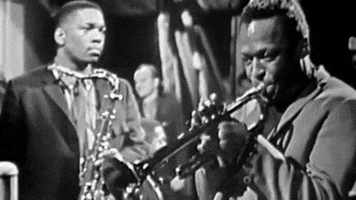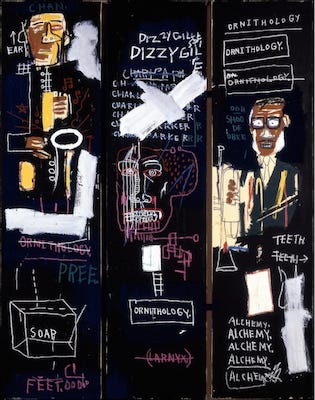Early last year as the world descended into lockdown, videos began to emerge of ebullient Europeans singing on their balconies, outside their doors, etc, in an attempt to maintain closeness with their neighbors and offer solidarity amidst the uncertainty. I recall seeing a tweet expressing how moving it was to see this camaraderie across Italy, Spain, China, and how it highlighted that Americans don’t have any songs to sing and that America isn’t a real nation. The moment I read the words I actually laughed out loud at the sheer cultural illiteracy expressed in such a statement but as the year wore on, through other various channels on social media, it became clear that we are now at a point where an entire generation is unfamiliar with integral eras in American music and the history that accompanies them. One such wake up call came while discovering a YouTube channel featuring two twenty-year-old twins reacting to music they’ve never heard before. It is revealing in and of itself to note the sheer volume of music that goes undiscovered in younger generations but more shocking still was seeing the reaction they have to it. In several of these videos, one of the twins is so instantly struck by the truth in the music and the honesty in voices like Ray Charles, Freddie Mercury, and Ella Fitzgerald, that he is brought to tears. Although he rarely has words for the emotional bell that is struck within him, the sentiment is undeniable: the Real reaches where nothing else can and transcends the final analysis of culture and all self-determined classification.
The most prolific American creative contribution to the world is the birth of Jazz, which in its golden age spawned hundreds of artists, thousands of songs including the entire Great American Songbook, and a generation of the most prolific songwriters, whose influence ultimately helped to inspire and shape rock and roll, Motown, and hip hop. Jazz is the quintessential root of the American music scene. Born in the brothels of New Orleans and given its name as reference to the sweet jasmine flower perfume worn by the girls there, the style of jazz exemplifies our undying push for ultimate freedom while existing drenched in the humidity of the human experience. Its body of song bends and moves like the muses who inspired it over a hundred years ago. Jazz is unpredictable and very much a meditation on the now, where there is no future or past, and no moment is recreatable.
A word from the incomparable Bill Evans:
More than being a stylistic medium, jazz music is, as Evans says, “a creative process of spontaneity”. It is the only reproducible art form in which each expression of the same framework is entirely unique. The songs are written to transcend the page, extemporaneously, like malleable sculptures capturing the spiritual frequency of a moment that can never be replicated. It is a living, evolving expression of total liberation and as Duke Ellington put it, “jazz is the only unhampered, unhindered expression of complete freedom yet produced in this country (America).”
I may be incurably biased toward appreciating this musical abstraction. Some of my earliest childhood memories are of being in jazz clubs, curled up in a booth next to my mother as she watched my father’s quartet summoning the ancestors on the bandstand. Memories from this era in my life are tactile and vivid, as if we are there now; blue light beaming through curls of smoke and a distant chorus of dishware, the velvets and brocades of my mother’s vintage kimonos, the way her antique brooches and jewels glimmered in the dim haze, the warm tones emanating from the musicians and their instruments, and always a stash of maraschino cherries ready for me. My mother, who had been a dancer up until my arrival and always truly wanted to be a singer, shared with my father a relationship to rhythm and movement. At home, it was not uncommon to find them trading eights in the basement for fun. Trading eights is a sort of discontinuous drum solo in which the drummer and another soloist take turns improvising, in this case my mother in her tap shoes, dad at the kit, each trying to outdo the other through their respective rhythmical traditions.
Jazz requires of its guardians a highly nuanced and subtle level of perception, both in playing it and enjoying it, and this keen attunement was evident in my parents’ dynamic as well. They had an understanding of the ever-present cosmic joke which birthed a language of tells between them that were imperceptible to anyone else - half spontaneous micro-gesture, half telepathy - but nonetheless completely keeping with the gradient nature inherent to the soundtrack of my childhood. Both my parents, ever the keen observers of human nature, brought to my early life an appreciation of subtlety that has stayed at the forefront of my awareness. My father was a comedian of the subtlest capacity - stealth roguery par excellence - with an absolute disdain for the mediocre. A cymbal crash from his hand could deliver the punchline of your life story. Jazz was a spiritual ritual for him, his portal to transcendence.
It comes as no surprise that throughout my life jazz music has been a reference point through which the great sigil of manifest reality has imparted much of its primordial wisdom. Its teachings offer a masterclass in total presence, meditation and flow, surrendering to spontaneity, dissolving the experiencer into the experience, the ageless quality of true art, the human need for randomness, for new pathways to be opened in the mind, and for non-referential creativity. Perhaps most applicable to our current predicament is that it teaches wildness within the architecture of a structure. The freedom and avant-garde totality of jazz music belies this fundamental lesson in creativity: that limitation defines creation.
Again, Mr. Evans:
“It’s very important to remember that no matter how far I might diverge or find freedom in this format, that it only is free in so far as it has reference to the strictness of the original form, and that’s what gives it its strength.”
In other words, set the parameters and improvise wildly within them.
It’s interesting to contemplate restriction in a society oversaturated with abundance to the point of fatigue or to speak of structure when the zeitgeist of the modern age seems pointed toward total transcendence. The era of seemingly infinite options is upon us where we can go anywhere, do anything, learn anything, be anything, and date anyone. The world has never been smaller, opportunity has never been more abundant, communication has never been faster, information has never been more accessible, but rarely do we contemplate the ramifications of such expansive excess. The age of abundance is birthing a new disease: the crippling inaction of too many options.
This dimension of existence requires a restriction, a limitation, to birth manifestation into appearance. There has to be a vessel of containment to restrict the infinite expanse into being, even if that structure exists in thought only. This sentiment is philosophically at odds with much of the new age doctrine which is based on an adherence to a mindset of unlimited, unconfined potentiality and is, in its own right, true. Everything is the infinite one substance of consciousness but what is sometimes overlooked in delineating the “living as infinite consciousness” model is this:
everything that appears in existence comes into view through the attenuation of consciousness limiting the scope of its vastness into perceivability.





